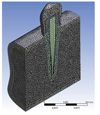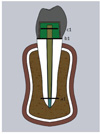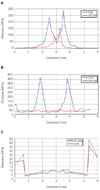Abstract
PURPOSE
The aim of the present study was to evaluate the effects of posts with different morphologies on stress distribution in an endodontically treated mandibular premolar by using finite element models (FEMs).
MATERIALS AND METHODS
A mandibular premolar was modeled using the ANSYS software program. Two models were created to represent circular and oval fiber posts in this tooth model. An oblique force of 300 N was applied at an angle of 45° to the occlusal plane and oriented toward the buccal side. von Mises stress was measured in three regions each for oval and circular fiber posts.
RESULTS
FEM analysis showed that the von Mises stress of the circular fiber post (426.81 MPa) was greater than that of the oval fiber post (346.34 MPa). The maximum distribution of von Mises stress was in the luting agent in both groups. Additionally, von Mises stresses accumulated in the coronal third of root dentin, close to the post space in both groups.
Root canal treatment consists of chemo-mechanical preparation and obturation, followed by adequate restoration.1 Because root canal-treated teeth often have significantly damaged coronal tooth structures, they commonly require posts to support the core material and promote retention of the final restoration.2-4
Fiber posts are generally preferred to metal posts for coronally damaged teeth to reflect the elastic modulus of the dentin, providing better adhesion between the dentin and fiber post and permitting more uniform stress distribution along the root dentin.4,5
The proportion of oval-shaped canals in human dentition is high, even in the apical region.6 Oval fiber posts have been introduced to prevent inappropriate post-space preparation in oval root canals. Oval fiber posts reduce the resin cement thickness and increase post-retention strength, as they anatomically reproduce the oval form of root canals.7
Several potential advantages of oval fiber posts over circular fiber posts have been reported, including reduced resin cement thickness,8 better open dentin tubule scores, and increased adhesion.9 Instead of using a rotary instrument to prepare the post space, a minimally invasive diamond-coated ultrasonic tip is used for the Ellipson oval fiber post (Ellipson tip; RTD/Satelec, Merigcac, France).7 Although studies have demonstrated that oval fiber posts are more successful in oval root canals,7,10 no study has compared the stress distribution of oval and circular fiber post systems.
The photoelastic technique and finite element analysis have been used to evaluate post failure in root canals in vitro and in vivo.11,12 The most frequent causes of post failure in core restorations are fracture and debonding.13 The main causes of bonding failure are especially inadequate bonding in the apical third of the root canal, interfacial gaps in the hybrid layer, microleakage and polymerization shrinkage stress (C factor). These failure factors show that outcomes depend mainly on operator's ability. The only method of analysis that eliminates operator factors and uses materials under ideal conditions is the finite element model (FEM).11,12 In the FEM, digitally modeled tooth structures are divided into simple geometric models, called elements, whose tips aggregate to generate nodes. Each modeled element layer has specific elastic constants, such as Young's elastic modulus (E) and Poisson's ratio (v).14 Thus, the FEM has become a reliable method for dental applications that enables the calculation of load distributions and the influence of model parameter variations once an accurate three-dimensional model is created.12
The purpose of the present study was to compare the stress distribution of circular and oval fiber posts in restored teeth using finite element analysis.
A 22 mm long mandibular premolar with a 7 mm crown height and a 15 mm root length was modeled for this study.12 The ANSYS software program (ver 12.1; ANSYS Inc., Canonsburg, PA, USA) was used to model the restored tooth and surrounding tissues. Two models of a restored tooth composed of a porcelain crown, dentin, composite core, crown-core adhesive layer, dentin-post adhesive layer, cortical bone, spongy bone, root canal gutta-percha filling, and oval and circular fiber posts, respectively, were created (Fig. 1 and Fig. 2).
Material properties are listed in Table 1.12 Using an optimization process based on convergence analyses, three-dimensional meshes (mean size, 0.5 mm) were created through 10 nodes of tetrahedral elements with quadratic displacement shape functions and three degrees of freedom per node. Numerical models comprised about 262,160 elements and 401,161 nodes for oval fiber posts, and 263,443 elements and 402,608 nodes for circular fiber posts; the continuity of displacement fields through material interfaces was imposed (Fig. 3).
D.T. Light circular fiber posts (Bisco Inc., Schaumburg, IL, USA) with apical diameters of 1.1 mm and Ellipson oval fiber posts (RTD/Satelec, Merigcac, France) with apical diameters of 1.1 mm were used in this study. The thickness of the luting material was assumed to be 200 µm between the post and root dentin and between the core and porcelain crown.
An oblique force of 300 N was applied at angle of 45° to the occlusal plane, oriented toward the buccal side (Fig. 4).12 The gingiva served as a fixed support for the boundary condition of the model (Fig. 4).
The periodontal ligament was eliminated from the model because its thin structure can distort of the elements12 All materials were considered to be homogeneous, isotropic, and linearly elastic. Thus, linear analyses were performed under defined loading conditions.
The applicable stress representation criterion was chosen based on an evaluation of the predicted potential for failure in the analysis performed. The von Mises (equivalent stress) energetic criterion was chosen as the best representation of a multi axial stress state. Three regions of the oval and circular fiber posts were evaluated: a) along the apical extent of the post (post tip), b) the core-root dentin interface from the labial to the palatal side, and c) 3 mm-above b, from the labial to the palatal side (Fig. 5).
The maximum distribution of von Mises stress occurred in the luting materials of oval and circular fiber posts. Within the luting material, the stress concentration of the circular fiber post was greater than that of the oval fiber post (Fig. 6A, Fig. 6B and Fig. 6C). von Mises stress in the root dentin was greater for the circular fiber post (426.81 MPa) than for the oval fiber post (346.34 MPa) (Fig. 7 and Fig. 8). In both groups, von Mises stresses were concentrated in the coronal third of root dentin, close to the post space.
The stress distributions of circular and oval fiber posts were evaluated using three-dimensional elastic finite element analysis. The results show that the oval fiber post system provides better stress distribution than the circular fiber post system.
The major shortcomings of standard fracture or stress studies are related to the use of different tooth structures, such as different dentin thicknesses and root canal shapes. Differences in tooth structure prevent the standardization of resin cement thickness and post-space preparation. Thus, the main advantage of this study was the use of FEMs, which provided the maximum level of standardization. Another advantage of this study is that the post space in the oval-shaped mandibular premolar model was prepared according to the manufacturers' directions, thereby avoiding operator errors that can occur in in vivo and in vitro studies.11,12
The aim of this study was to evaluate stress distribution in a tooth model using posts made of the same fiber material but with different geometrical shapes. Non-linear FEM analysis was used to calculate plastic deformation and geometrical properties. Thus, linear FEM analysis adequately described von Mises stress distribution in this study.
To validate the FEMs, their accuracy was controlled by a convergence test. After the convergence test, the two models were composed of 262,160-263,443 elements and 401,161-402,608 nodes. These large numbers of elements and nodes in the current FEMs provide more reliable results than achieved in previous studies.11,12,14,15
Maceri et al.14 stated that oblique loads are more hazardous than vertical loads on endodontically restored teeth. Thus, an oblique load was used in this study to reflect parafunctional loads related to bruxism and to limit the chewing conditions in the case of very tough foods. When the mandibular premolar was subjected to 45° occlusal loading, stress was concentrated on the coronal side of the root dentin.12
In a finite model of a mandibular premolar with a fiber post restoration, Boschian Pest et al.11 observed the highest level of von Mises stress between the luting material and root dentin under the 486 N chewing force. In addition, the authors showed that stress was concentrated in the coronal part of the root.11 The stress fields were also non-homogeneous in the coronal region of the root, as reported in previous FEM studies of simulated crowns and ferrules in teeth restored with fiber posts and composite resin cores.16-18
In an FEM study, Hsu et al.12 applied 300 N force at an angle of 45° to the palatal surface of maxillary central incisor with a fiber post restoration, and reported that the maximum stress was concentrated between the root dentin and adjacent cortical bone. In the current study, maximum von Mises stress values were observed between the luting material and root dentin; these results are compatible with Boschian Pest et al.11 but differ from those of Hsu et al.12 The discrepancy in results among these studies may be due to the use of different tooth models, resulting in differences in loading points and distributions.
In this study, we found that fiber post geometry may affect stress distribution. In contrast, de Castro Albuquerque et al.15 found that post geometry and material did not affect stress distribution in an analysis of tapered, cylindrical, and two-stage cylindrical posts made of three different materials. This difference may be due to the use of different loading forces (100 N), tooth models (two-dimensional central incisor) and materials with different geometrical designs.
Aggarwal and Garg19 used an FEM to evaluate stress concentrations in endodontically treated maxillary central incisors restored with three fiber post systems: D.T. Light, Luscent Anchor (Dentatus, NY, USA), RelyX (3M ESPE, St. Paul, MN, USA) fiber posts with a double-tapered, parallel shape, tapering of the last 1.8 mm of the apical end, and uni-tapering (8%) in the middle third of the post, respectively. The authors found that the RelyX post generated the least amount of stress and attributed the results to the material (glass fiber) and the parallel placement of the fibers.19 However, the authors did not consider that the different geometrical designs of the post systems may also have affected the results.19 In our study, we used the Ellipson oval fiber post and D.T. Light fiber post because they are composed of quartz fiber, and have the same Young's modulus and Poisson's ratio; thus, they differ only in geometrical design, allowing evaluation of the effect of post geometry on stress distribution.
Within the limitations of this study, circular fiber posts generated more stress than oval fiber posts.
In the present study, circular fiber posts generated more stress than did oval fiber posts in a mandibular premolar. This suggests that post geometry has very important effect on stress distribution at the post-dentin interface. Interfacial stresses can be higher in post-core restorations using circular fiber posts than in those with oval fiber posts. The adhesive and cohesive interfacial failure risks are thus greatly reduced in oval fiber post-core restorations, which showed greater durability (less fatigue) under cyclic loading.
Figures and Tables
 | Fig. 3The meshed model had 262,160 elements and 401,161 nodes for oval fiber post and 263,443 elements and 402,608 nodes for circular fiber post. |
 | Fig. 4Model loading conditions. The boundary condition of the model was a fixed support at the surface of the gingiva. |
References
1. Hess D, Solomon E, Spears R, He J. Retreatability of a bioceramic root canal sealing material. J Endod. 2011; 37:1547–1549.
2. Cecchin D, de Almeida JF, Gomes BP, Zaia AA, Ferraz CC. Effect of chlorhexidine and ethanol on the durability of the adhesion of the fiber post relined with resin composite to the root canal. J Endod. 2011; 37:678–683.
3. Faria-e-Silva AL, Pedrosa-Filho Cde F, Menezes Mde S, Silveira DM, Martins LR. Effect of relining on fiber post retention to root canal. J Appl Oral Sci. 2009; 17:600–604.
4. Kremeier K, Fasen L, Klaiber B, Hofmann N. Influence of endodontic post type (glass fiber, quartz fiber or gold) and luting material on push-out bond strength to dentin in vitro. Dent Mater. 2008; 24:660–666.
5. Giachetti L, Scaminaci Russo D, Baldini M, Bertini F, Steier L, Ferrari M. Push-out strength of translucent fibre posts cemented using a dual-curing technique or a light-curing self-adhering material. Int Endod J. 2012; 45:249–256.
6. Muñoz C, Llena C, Forner L. Oval fiber posts do not improve adaptation to oval-shaped canal walls. J Endod. 2011; 37:1386–1389.
7. Coniglio I, Magni E, Cantoro A, Goracci C, Ferrari M. Push-out bond strength of circular and oval-shaped fiber posts. Clin Oral Investig. 2011; 15:667–672.
8. Coniglio I, Garcia-Godoy F, Magni E, Carvalho CA, Ferrari M. Resin cement thickness in oval-shaped canals: oval vs. circular fiber posts in combination with different tips/drills for post space preparation. Am J Dent. 2009; 22:290–294.
9. Coniglio I, Carvalho CA, Magni E, Cantoro A, Ferrari M. Post space debridement in oval-shaped canals: the use of a new ultrasonic tip with oval section. J Endod. 2008; 34:752–755.
10. Clark DJ. Shaping and restoring ovoid canal systems. Endod ther. 2005; 5:9–13.
11. Boschian Pest L, Guidotti S, Pietrabissa R, Gagliani M. Stress distribution in a post-restored tooth using the three-dimensional finite element method. J Oral Rehabil. 2006; 33:690–697.
12. Hsu ML, Chen CS, Chen BJ, Huang HH, Chang CL. Effects of post materials and length on the stress distribution of endodontically treated maxillary central incisors: a 3D finite element analysis. J Oral Rehabil. 2009; 36:821–830.
13. Martínez-Insua A, da Silva L, Rilo B, Santana U. Comparison of the fracture resistances of pulpless teeth restored with a cast post and core or carbon-fiber post with a composite core. J Prosthet Dent. 1998; 80:527–532.
14. Maceri F, Martignoni M, Vairo G. Mechanical behaviour of endodontic restorations with multiple prefabricated posts: a finite-element approach. J Biomech. 2007; 40:2386–2398.
15. de Castro Albuquerque R, Polleto LT, Fontana RH, Cimini CA. Stress analysis of an upper central incisor restored with different posts. J Oral Rehabil. 2003; 30:936–943.
16. Pierrisnard L, Bohin F, Renault P, Barquins M. Coronoradicular reconstruction of pulpless teeth: a mechanical study using finite element analysis. J Prosthet Dent. 2002; 88:442–448.
17. Eskitaşcioğlu G, Belli S, Kalkan M. Evaluation of two post core systems using two different methods (fracture strength test and a finite elemental stress analysis). J Endod. 2002; 28:629–633.
18. Pegoretti A, Fambri L, Zappini G, Bianchetti M. Finite element analysis of a glass fibre reinforced composite endodontic post. Biomaterials. 2002; 23:2667–2682.
19. Aggarwal S, Garg V. Finite element analysis of stress concentration in three popular brands of fiber posts systems used for maxillary central incisor teeth. J Conserv Dent. 2011; 14:293–296.




 PDF
PDF ePub
ePub Citation
Citation Print
Print









 XML Download
XML Download